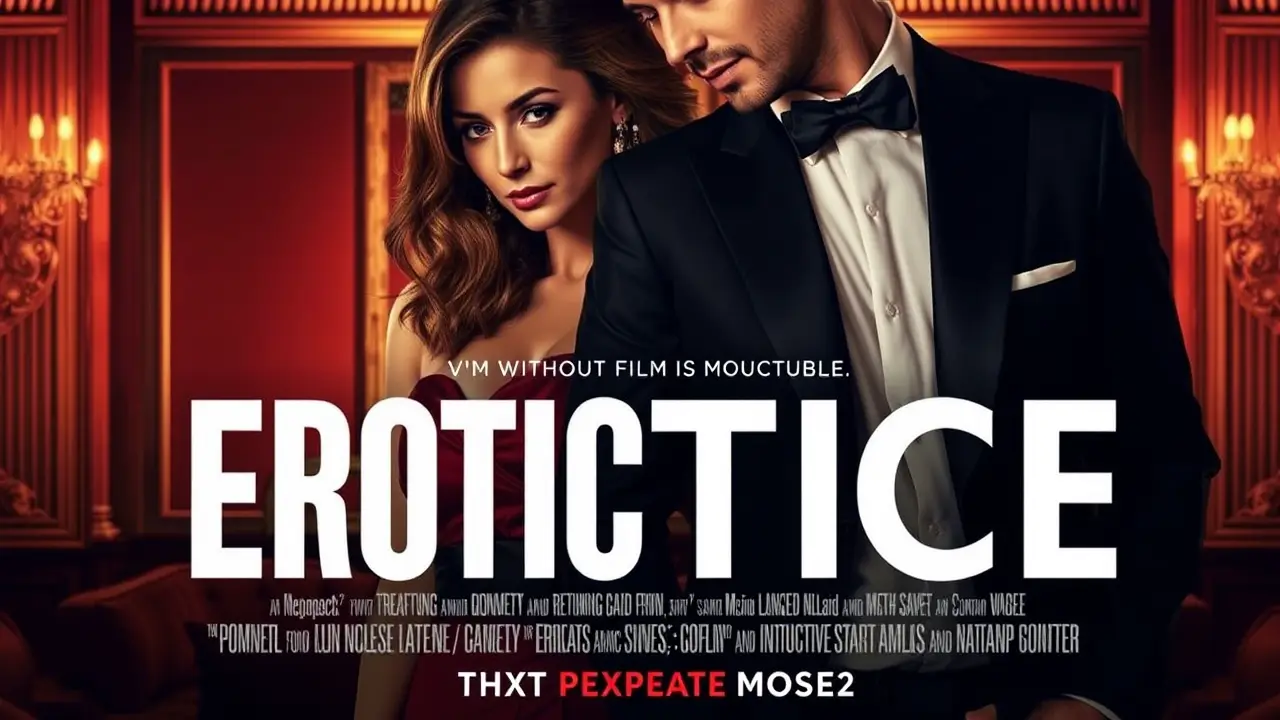Hello and welcome to 9flix.com.ng, in this blog post, we shall be diving in deeper into the topic: Erotic Movies: The Evolution and Unveiling Desire.
In the vast landscape of cinema, few genres have experienced as complex a journey as erotic movies. From early silent films with their subtle suggestions to the sophisticated narratives of modern cinema.
The evolution of erotic movies reflects changing societal attitudes toward sexuality, censorship battles, and the ongoing conversation about the distinction between art and exploitation.
Erotic Movies: The Evolution and Unveiling Desire

This exploration of Unveiling Desire: The Evolution of Erotic Movies, takes us through the rich history of erotic cinema—examining its origins, watershed moments, cultural impacts, and how the digital age has transformed both its production and consumption.
By understanding erotic movies and it’s evolution, we gain insight into how societies negotiate the representation of human desire on screen and how filmmakers have pushed boundaries to create works that are provocative, meaningful, and sometimes revolutionary.
The Birth of Cinematic Eroticism
The relationship between film and eroticism began almost as soon as motion pictures were invented. Even in cinema’s earliest days, filmmakers recognized the medium’s unique ability to capture and convey human intimacy.
The Early Explorations of Erotic Movie (1896-1920s)
The first known erotic film, “Le Coucher de la Mariée” (Bedtime for the Bride), produced in France in 1896, featured actress Louise Willy performing a striptease. This 7-minute film established what would become a pattern—European productions leading the way in exploring sexuality on screen while American films remained comparatively conservative.
Early erotic cinema existed in a unique space before formal censorship systems were established. Short films like “The Kiss” (1896) caused controversy despite showing merely a brief kiss—considered scandalous at the time.
Meanwhile, in pre-war Europe, films like “Extase” (Ecstasy, 1933) featured Hedy Lamarr in what is considered the first non-pornographic film to portray a female orgasm through close-ups of her face.
Silent Era Sensuality
The silent era paradoxically allowed for greater expression of sensuality in some ways. Without dialogue, these films relied heavily on visual storytelling and physical performance to convey desire.
Films like “Flesh and the Devil” (1926) with Greta Garbo showcased passionate scenes that communicated powerful eroticism through glances, touches, and suggestive imagery rather than explicit content.
During this period, the distinction between mainstream cinema and “stag films” (early pornography shown at private men’s gatherings) remained clear, though both explored human sexuality from different angles and for different purposes.
The Code Era: Censorship and Subterfuge
The implementation of the Motion Picture Production Code (commonly known as the Hays Code) in 1934 dramatically altered how sexuality could be portrayed in American cinema.
Working Within Constraints (1930s-1950s)
Under the Code’s strict regulations, even married couples were shown in separate beds, and any suggestion of sexual impropriety required narrative punishment for the characters involved. Filmmakers developed ingenious ways to suggest eroticism within these constraints:
- Using symbolic imagery (trains entering tunnels)
- Focusing on non-sexual physical intimacy (passionate kisses)
- Employing suggestive dialogue with double meanings
- Creating tension through clothed encounters (the famous beach scene in “From Here to Eternity”)
European cinema operated under different standards. Films like “Les Amants” (The Lovers, 1958) by Louis Malle featured sexual content that would have been impossible in American productions of the time, showcasing how cultural attitudes shaped cinematic expression.
Exploitation and Underground Cinema
While mainstream Hollywood navigated censorship, a parallel industry of “exploitation” films emerged. These low-budget productions used sensational elements, including nudity and sexual situations, to attract audiences. Films like Russ Meyer’s “The Immoral Mr. Teas” (1959) found success in this gray area between mainstream cinema and pornography.
Simultaneously, underground and experimental filmmakers explored sexuality as artistic expression. Kenneth Anger’s “Fireworks” (1947) and other avant-garde works used erotic imagery to challenge conventions and express suppressed desires, particularly regarding homosexuality and other identities marginalized in mainstream cinema.
Sexual Revolution and Cinema Liberation
The cultural shifts of the 1960s and the eventual collapse of the Production Code in 1968 (replaced by the MPAA rating system) opened new possibilities for erotic expression in film.
New Hollywood and European Influences (1960s-1970s)
This period saw watershed moments in erotic cinema:
- “I Am Curious (Yellow)” (1967) from Sweden pushed boundaries with its integration of explicit sexuality and political themes
- “Last Tango in Paris” (1972) with Marlon Brando brought explicit sexuality into art-house cinema
- “Emmanuelle” (1974) found mainstream success and spawned a franchise that normalized erotic cinema for wider audiences
The line between art and exploitation became increasingly blurred. Films like “The Opening of Misty Beethoven” (1976) attempted to bring production values and narrative complexity to explicit films, creating what some called “porno chic.”
Erotic Thrillers and Mainstream Integration
The 1980s and 1990s saw the rise of the erotic thriller, a genre that combined suspense, noir elements, and explicit sexuality. Films like “Body Heat” (1981), “9½ Weeks” (1986), and “Basic Instinct” (1992) brought erotic content firmly into mainstream cinema, often with significant commercial success.
These films reflected the era’s complicated attitudes toward sexuality—simultaneously more open than previous decades yet often equating sexuality (particularly female sexuality) with danger. The AIDS crisis also cast a shadow over sexual representation during this period, sometimes manifesting as subtext in these thrillers.
Art Cinema and Sexual Authenticity
While Hollywood explored eroticism through the thriller genre, art-house cinema took different approaches to sexuality on screen.
The New Extremity and Unsimulated Sex
A movement some critics called the “New French Extremity” emerged in the late 1990s and early 2000s. Directors like Catherine Breillat (“Romance,” 1999), Gaspar Noé (“Irreversible,” 2002), and Michael Winterbottom (“9 Songs,” 2004) incorporated unsimulated sex acts into narratives dealing with complex themes of desire, power, and intimacy.
The Unveiling Desire Erotic Films

These films sparked debate about the purpose of explicit sexuality in cinema—was it necessary for authenticity or merely provocative? The controversy surrounding these works highlighted continuing tensions about erotic representation, even in supposedly progressive artistic contexts.
LGBTQ+ Perspectives and Diverse Desires
The evolution of erotic cinema also reflects the increased visibility of diverse sexual identities. Films like “Blue is the Warmest Color” (2013), “Moonlight” (2016), and “Call Me by Your Name” (2017) brought nuanced portrayals of non-heterosexual desire to wider audiences, often receiving critical acclaim.
These films approached sexuality through lenses of identity, coming-of-age, and emotional connection rather than mere physical gratification. This shift represented a maturation in how eroticism could be explored on screen—as part of complex human experiences rather than spectacle.
The Digital Revolution and Erotic Cinema
The internet age has fundamentally transformed both the production and consumption of erotic content, creating new challenges and opportunities for filmmakers.
Democratization and Accessibility
Digital technology has democratized production, allowing independent filmmakers to create erotic content outside traditional funding structures. Platforms like OnlyFans have further blurred the lines between creator and performer, audience and participant.
Streaming services initially seemed poised to create new opportunities for adult-oriented content, though many have ultimately proven conservative in their programming decisions. However, international content often features more explicit material than domestically produced shows and films in the US market.
Virtual Reality and Interactive Experiences
Emerging technologies are creating entirely new forms of erotic media. Virtual reality adult content creates immersive experiences, while interactive elements allow for personalization previously impossible in traditional film formats.
These developments raise new questions about the nature of cinematic experience itself. When viewers can potentially control the action or experience content as if physically present, does this fundamentally change what we consider “film”? The evolution continues as technology advances.
Critical Perspectives: Feminism, Ethics, and Representation
No discussion of erotic cinema would be complete without addressing the ongoing debates surrounding its ethics and impact.
Feminist Approaches and Female Gaze
The question of who controls the narrative in erotic cinema has evolved substantially. Early feminist film criticism often focused on the objectification of women through the “male gaze”—a concept introduced by Laura Mulvey that describes how cinema is often constructed to satisfy heterosexual male viewers.
Contemporary female directors like Erika Lust, Jennifer Lyon Bell, and others have worked to create what some call a “female gaze” alternative—erotic content created with women’s desire and pleasure in mind.
These productions often emphasize context, emotional connection, and authentic pleasure rather than performances designed primarily for male viewers.
Ethical Production and Consumption
Questions about ethical production have become increasingly central to discussions of erotic media. Concerns about performer consent, working conditions, and exploitation have led to movements for ethical production practices.
Viewers have become more conscious about the ethics of their consumption habits, with some seeking out performer-produced content, feminist productions, or material created under fair labor practices. This represents a significant shift in how audiences engage with erotic content, considering the conditions of its creation alongside its appeal.
The Future of Erotic Cinema
As we look forward, several trends suggest the continuing evolution of erotic movies:
Integration of Technology and Intimacy
Artificial intelligence, virtual reality, and other emerging technologies will likely continue to transform how erotic content is created and experienced. These technologies may offer new possibilities for personalization, interactivity, and forms of intimacy not possible in traditional cinema.
The boundary between participant and observer may become increasingly permeable, raising both exciting possibilities and ethical questions about simulation, consent, and the nature of intimacy itself.
Global Perspectives and Cultural Exchange
As global cinema becomes more interconnected, different cultural approaches to sexuality on screen continue to cross-pollinate. From the romantic sensuality of certain French cinema to the complex negotiation of tradition and desire in films from Asia and the Middle East, global perspectives enrich the landscape of erotic filmmaking.
This cultural exchange offers audiences diverse perspectives on desire and intimacy that move beyond Western frameworks, potentially expanding our understanding of how eroticism can be portrayed.
The Continuing Quest for Authenticity
Perhaps the most enduring trend in the evolution of erotic cinema is the search for authentic representations of human sexuality. From art-house directors seeking to capture genuine intimacy to independent adult filmmakers emphasizing real pleasure, the quest to represent desire authentically remains central.
This authenticity may manifest in different ways—through diverse body types, ages, and abilities represented on screen; through performances that prioritize genuine connection over spectacle; or through narratives that engage with the complex reality of human sexuality rather than fantasy projections.
Conclusion: Beyond Titillation
The evolution of erotic movies: reflects our complex relationship with sexuality, art, and representation. From tentative early explorations to boundary-pushing contemporary works, this genre has continuously negotiated the tensions between artistic expression, commercial appeal, and social norms.
At its best, erotic cinema does more than titillate—it explores fundamental aspects of human experience, challenges us to examine our attitudes toward desire, and expands our understanding of intimacy.
The most significant erotic films have never been merely about sex, but about human connection, vulnerability, power, and the myriad ways these elements intersect in our lives.
As technology, social attitudes, and artistic approaches continue to evolve, erotic cinema will undoubtedly transform as well. Yet its core function—exploring desire through moving images—remains as relevant today as when the first filmmakers pointed their cameras at kissing couples over a century ago.
In tracing this evolution, we see not just how depictions of sexuality have changed, but how our understanding of desire itself has transformed across time and cultures.